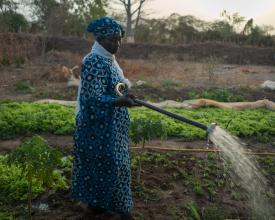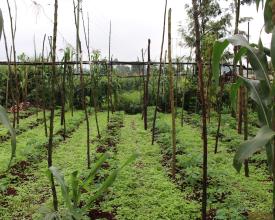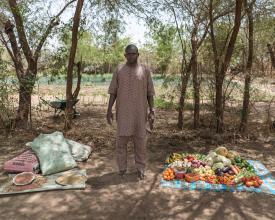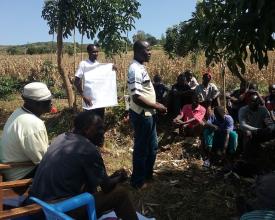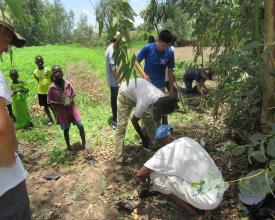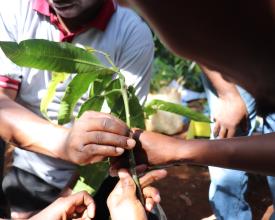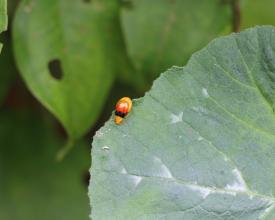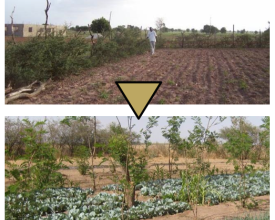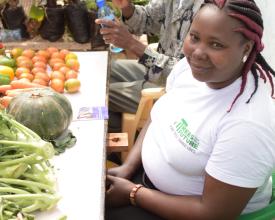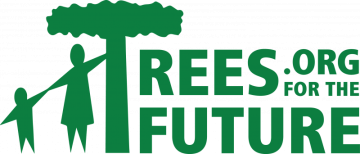
Reaching Sustainable Development Goals through the Forest Garden Approach (FGA)
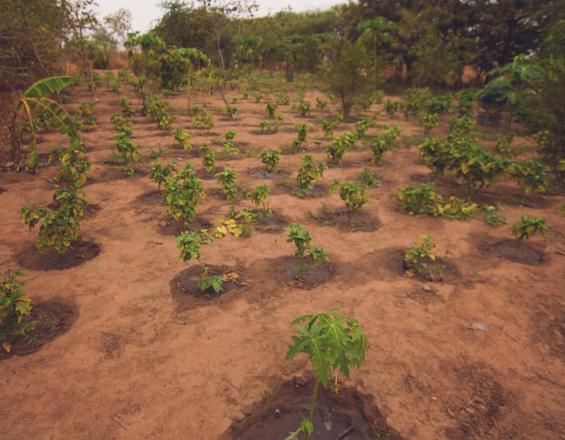
While industrial farming practices contribute to a changing climate, agriculture done right has the ability to save the planet! That’s why Trees for the Future (TREES) helps farmers in the developing world to increase food security, generate sustainable income, and revitalize degraded lands through the Forest Garden Approach (FGA). Each year, TREES works directly with about 5,000 farming families consisting of over 30,000 people and teaches them 14 different agroforestry modules over a 4-year program. Annually, TREES helps farmers plant 20 million trees and cultivate farms to grow, on average, 27 varieties of crops/shrubs on land thought to be infertile. This achieves average income gains of an average 400% over four years. TREES also collaborates with agricultural development and food assistance organizations to train extension experts in the FGA to help others adopt sustainable, climate-smart agriculture programming, amplifying these powerful impacts.
Contexto
Défis à relever
-
Diseases/pests - The plant diversity inherent in FGs helps stop initiation/spread of any 1 pest by mimicking nature, offering refuge for predators and buffers between potential disease transmittance sites. Our flexible trainings allow delivery of integrated pest management (IPM) trainings before outbreaks arise to prevent the spread of harmful insects, and to teach farmers to use homemade, non-toxic pesticides.
-
Climate changes & Water Access - We assess farmers' water access before projects and select sites with greater water access. Farmers maximize rainwater use by harnessing the slope/natural features of the land to help water flow where needed. We also plant locally-adapted, drought/flood tolerant species and ensure that seedlings are planted when rainy seasons begin.
-
Market fluctuations - FGs provide larger sets of marketable products to generate revenue. Species grown in each FG are determined by market studies, partners, and farmers.
Ubicación
Procesar
Summary of the process
These building blocks are the 5 phases of the Forest Garden Approach. TREES begins the approach by undergoing the mobilization phase, where and how we hire local staff, obtain funding and partners for the project, which allows us to progress into the Protection phase. This phase protects farmers land from outside threats, like wind/animals, so they can begin planting higher-value crops, like they do in the Diversification phase. This phase teaches them how to manage their FG, so they are able to learn important practices, such as conservation techniques in the Optimization phase for long-term success. This final phase teaches farmers how to be successful after the program ends, which readies them for the Graduation phase. The phases are designed to build upon one another and give each farmer the tools he/she needs for success after the four-year program, and the information to pass on a new way of farming to their own children and other community members.
Throughout this process, TREES is continually monitoring and evaluating projects on data points such as tree cover, economic and environmental resilience, food security, dietary diversity, etc. to understand how to improve these building blocks for current and future projects.
Building Blocks
Mobilization of Farmers
We hire project staff and meet with relevant stakeholders (government representatives, community leaders, and potential local and international partners/donors) to solicit their support and formalize each new FG project. With the help of stakeholders we identify interested farmer groups, lead farmers, and participants, and host orientation workshops prior to pursuing training and extension activities. We contact farmers by working with local government and community leaders and using rural radio to promote TREES and the FGA. This process takes 1-2 months as we vet farmers to ensure that they are truly willing to participate in the program. We prepare our Monitoring and Evaluation process which consistently collects data over the 4-year period. The M&E process consists of collecting information on our farmers through a baseline survey before they start the program, on metrics such as household dietary diversity and food insecurity and resilience (based off of USAID indices), along with measurements of the species diversity, and the number of trees per hectare on FG land. Lastly, we look into the number of food crops and marketable products our farmers grow. This information is followed up with an annual sample survey of farmers to see how these metrics change over the 4-year FGA.
Enabling factors
-
Finding farmers who are able to commit to the four-year program
-
Finding appropriate stakeholders/funders
-
Ability to find appropriate staff members to serve as technicians to train farmers
Lesson learned
We need to ensure that selection criteria includes a consultation with local leaders to be certain that farmers can dedicate secured, tenured (customary or statutory) land to the project
Protecting Farmland
This block consists of providing farmers with the skills and resources needed to protect their Forest Garden sites. Farmers achieve this by planting green walls – an enhanced version of a living fence that TREES has developed – around the perimeters of their sites. They then plant fast-growing fertilizer trees throughout their sites, often in alleys among their crops, to further stabilize their soils and enhance land fertility. We decide which species to grow based on which species adapt best to the agro-ecological zones where we work. We consult with the farmers themselves on what they want to grow, eat, and sell and our technicians advise farmers on the best way to plant and plant, iterating year-on-year changes that may enhance their garden, sales, and production. For example in drier climates like Senegal and Singida, Tanzania, we train farmers on growing various acacia species, which do not require much rain. We also promote nitrogen-fixing trees and crops, such as gliricidia species, acacia species, pigeon peas, and fruit trees that have a shorter maturing period (3-5) years. We also grow species based on what is culturally popular, nutritious, and marketable, like bananas, a staple food in Uganda.
Enabling factors
-
Fully trained technicians
-
Farmer’s land needs to be prepared and designed for FG implementation
Lesson learned
Integrated pest management is crucial in early stages of FGA as newly planted crops/trees can easily be hurt by diseases and pests
Diversification of Farmland
Farmers diversify the products they grow in their Forest Gardens. During this phase, farmers plant higher-value vegetables, fruit, nut, and timber trees. They also learn increasingly advanced skills and techniques that will help them manage their Forest Gardens more effectively and sustainably, such as fruit tree grafting, advanced composting, and marketing of crops.
Enabling factors
-
Farmers need to follow training modules very strictly to ensure success of their FG
-
Training materials can be downloaded on our Forest Garden Training Center (training.trees.org), which allows users to become a certified FG Practitioner. In 2019, this information will be developed into an mobile app, allowing trainers to access materials offline.
-
In the field, farmers are in constant contact with their technician/other farmers. They are given farmer workbooks to guide them and to take notes and draw pictures in.
-
Lesson learned
-
Crop diversification gives farmers more nutritious foods for them and their families, and;
-
Farmers now have products they can sell at markets to boost income to either save or invest in their FG
Optimization of Land
Farmers will learn to adopt advanced Forest Garden planting and care, integrated pest management, and conservation techniques that optimize and ensure the long-term health, productivity, and profitability of their land.
Enabling factors
-
Farmers are prepared for site visits
-
Technicians perform site visits monthly, and contents of the visit vary by which phase of the project the farmers are in
-
For example, Technicians:
-
check on tree planting and tree health
-
review training modules with farmers
-
check on crop progress
-
make sure farmers adhere to the approach (i.e. not using chemical fertilizers or pesticides, etc.)
-
make sure farmers have the tools to manage any problems that should arise (pest infestations, farm management)
-
-
Lesson learned
Need to regularly check in on farmers to ensure that they have implemented their Forest Gardens and are practicing the skills they have learned
Graduation of Farmers
Farmer groups develop business and advanced marketing plans to guide their continued activities and farm and business growth. When we initially select farmers, we ensure they are a part of a farmers group, which enhances their power as sellers, as they can sell in bulk and work as a group to market crops.. In Kaffrine, Senegal and Singida, Tanzania, some of our farmers grow higher-value crops like Hibiscus, Cashew, and Sunflower:We build capacity of farmers to approach buyers in regional capitals export quality crops . In Kenya, we work with a dairy cooperative to offset their cattle feed costs, and give them the opportunity to sell extra tree fodder they product to other cooperative members. Ownership of the project is fully transferred to the farmer groups. After graduation, farmer groups continue to support each other as a team in the on-going development and management of Forest Gardens and marketing of products.
After the 4-year project, farmers are expected to continue their Forest Gardens, given the significant successes they have seen and training they have received. In the future, TREES is hoping to follow-up with farmers after the program, however we do not yet have the capacity to continue monitoring farmers outside of the 4-year program.
Enabling factors
-
Farmers have successfully made it through the 4-year program
-
Farmers are willing to continue their FG after they graduate
Lesson learned
Farmers who graduated from the program were able to continue their FGA without the regular visits from TREES that they received during the program (follow-up visits and sample surveys show this).
Impacts
TREES measures our impacts in three categories: social, economic and environmental.
Social impacts include ending hunger for most families after only one year of the four-year FGA. Only 13% of FGA farmers are food secure when joining the program, and after just one year of planting Forest Gardens (FGs), 86% of FGA farmers are food secure. FGA success lies within the diversification of food crops and marketable products, which farmers increase from 2 to 7 for each farmer within the first 2 years.
Economic impacts include improving the lives of farming families and children. Farmers see significant income increases (up to 400%) with more than 92% of FGA farmers feeling capable with their new resources to brace for any unforeseen circumstances the future may bring.
Environmental impacts include ending deforestation, revitalizing soil through nitrogen-fixing trees, promoting healthy water tables, and maintaining/sustaining area biodiversity. By decreasing the use of harmful farming practices (burning, clearing, plowing), FGs reduce deforestation by eliminating farmers' dependence on forests for food, timber, and non-timber forest products. Furthermore, traditional agriculture has a heavy carbon footprint, mainly due to harmful agro-chemicals. FGs sequester carbon that is built up on-farm biomass. Each FG sequesters an average rate of 62.8 tons of carbon over about a 20 year period.
Beneficiaries
Each year, the FGA directly benefits a new set of 5,000 farmers and 30,000 indirect beneficiaries. We also train food assistance organizations to implement the FGA, so this wide network of practitioners/extension agents benefit from virtual training.
Sustainable Development Goals
Story
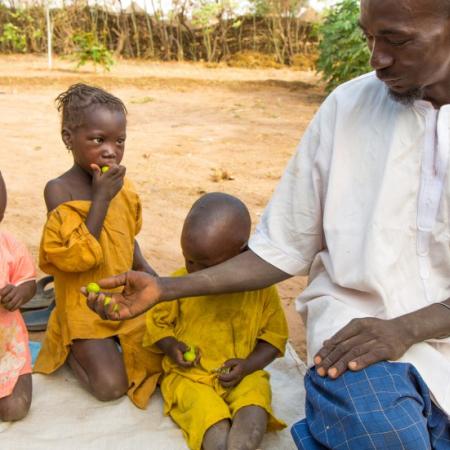
Malik doesn’t know about the Sustainable Development Goals: But he’s meeting them. Decades of backbreaking subsistence farming had left Malik Ndao and his family hungry and hopeless. He struggled for years, but the barren land with dying soils never produced enough to feed his children. Now he has a brighter future. A future filled with joy and hope. A future where his hard work in a Forest Garden provides a better life for his family. Malik and his wife have five children. Their farm never provided enough to feed the family. He was often away for months, desperately trying to make additional money to feed his family. He would search for work in markets across Senegal, attempting to earn tips by pushing wheelbarrows and carrying boxes. Sometimes hunger drove him to raid the local forest for wood and fruit, where he gathered anything he could eat or sell. He was barely surviving and never able to dream of a better life. Then, three years ago, Malik and his wife started his Forest Garden project with Trees for the Future. Now they have a Forest Garden System with 2,463 trees. The trees yield something of value to trade or sell every day of the year! Today, Malik does not feel desperate and hopeless. He no longer needs to leave his village to work. He is no longer away from his family for weeks and months at a time. Now his family, including his mother, wife and five children, are well fed. Last year, their two-acre Forest Garden generated over $1,260 – five times more than what maize and peanut farmers earn from the same amount of land. Now, Malik is doing something he never even dreamed he could accomplish. He is putting money aside in savings. Scaling up? But there are many others like Malik we can help feed their families and build a future filled with promise and hope. 90% of his neighbors and friends are still skipping meals and chronically worried they won’t have enough to eat. “I thank you to the point of wanting to dance!” says Malik. Together we can make many more families dance.


